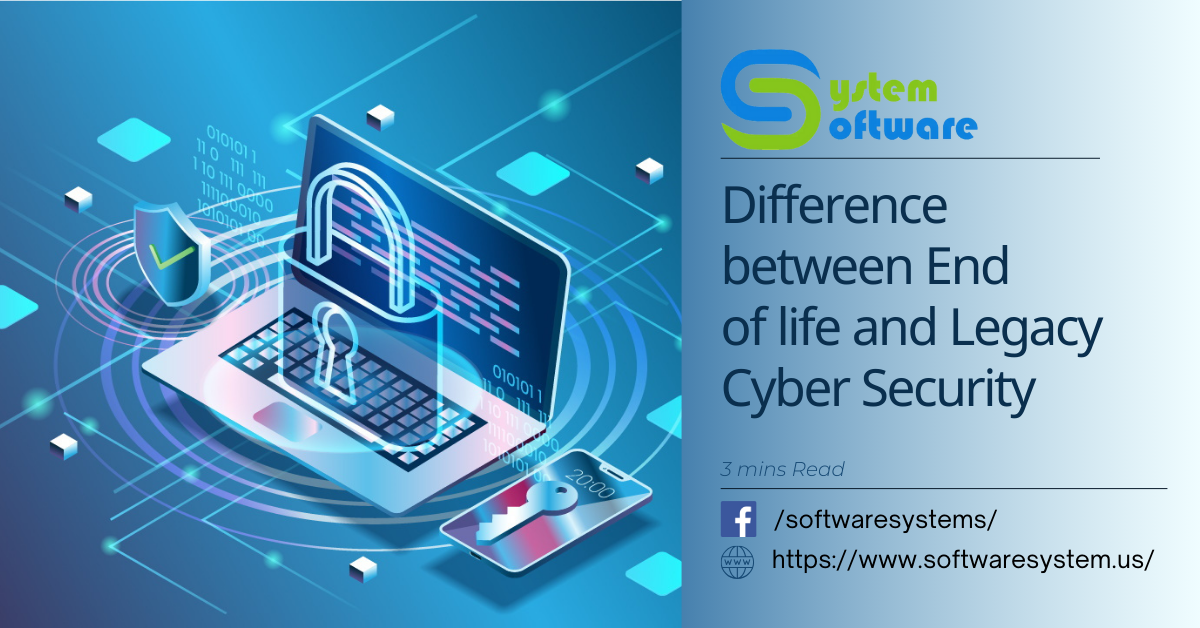In today’s fast-paced technological world, businesses must adapt to cybersecurity challenges. As systems and software age, they may reach a point where they no longer receive manufacturer support, exposing organizations to significant risks. Understanding End-of-Life (EOL) and Legacy Systems is crucial for maintaining operational security and ensuring compliance. This guide at Software Systems, a Technology Services Company examines the Difference between End of life and Legacy Cyber Security, their cybersecurity implications, and practical strategies to manage or transition from these outdated technologies.
Table of Contents

What Is End of Life in Cybersecurity?
End-of-Life (EOL) refers to the point when a manufacturer stops offering support, updates, and fixes for a specific product, leaving it vulnerable to cyber threats.
Key Reasons Systems Reach EOL:
| Reason | Explanation |
| Emerging Technology | Newer, advanced systems render old ones obsolete. |
| High Maintenance Costs | Maintaining outdated systems becomes financially unviable for vendors. |
| Limited Resources | Vendors prioritize creating and supporting newer technologies. |
Once a system reaches EOL, any vulnerabilities that emerge remain unaddressed, leaving the system susceptible to exploitation.
Why Do Businesses Continue Using EOL Systems?
Despite the risks, many organizations continue using EOL systems. Common reasons include:
| Reason | Description |
| Cost Constraints | Replacing systems is expensive, especially for small businesses. |
| Operational Dependencies | Legacy processes rely on specific software or hardware. |
| Compatibility Issues | Newer systems may not integrate seamlessly with existing workflows. |
While this approach might save money initially, the long-term risks outweigh the short-term benefits.
Security Risks of End-of-Life Systems
| Risk | Details |
| Unpatched Vulnerabilities | No updates mean hackers can exploit known weaknesses indefinitely. |
| Compliance Violations | Using EOL systems can breach GDPR, HIPAA, or PCI DSS requirements. |
| Increased Attacks | EOL systems are prime targets for cybercriminals. |
| Operational Downtime | System failures or breaches disrupt productivity and increase costs. |
What Are Legacy Systems in Cybersecurity?
Legacy systems are older technologies still in use but not necessarily obsolete. While functional, they often struggle to keep up with modern cybersecurity advancements and compatibility standards.
Features of Legacy Systems:
| Feature | Description |
| Partial Support | May still receive updates and patches, albeit inconsistently. |
| Incompatibility | May not work with modern tools or updated systems. |
| Performance Gaps | Slower and less efficient compared to modern systems. |
Proper management and care can help mitigate the risks associated with legacy systems.
Managing Legacy Systems
Effective management of legacy systems can reduce security risks and extend their usability. Key strategies include:
| Strategy | Action Plan |
| Regular Patching | Apply updates as soon as they are available. |
| Network Segmentation | Isolate legacy systems from critical business operations. |
| Constant Monitoring | Use modern tools to track network activities for potential threats. |
| Data Encryption | Encrypt sensitive data to prevent unauthorized access during breaches. |
| Backups | Regularly back up data to ensure recovery in case of a failure or attack. |
Difference between End of life and Legacy Cyber Security
| Criteria | Legacy Systems | EOL Systems |
| Support | Receives limited support. | No support or updates. |
| Vulnerability | Potential vulnerabilities if not properly managed. | High vulnerability to cyber threats. |
| Management | Requires consistent monitoring and updates. | Cannot be managed effectively. |
| Usability | Can function with updates and careful handling. | Poses significant operational risks. |
Cybersecurity Risks: Legacy vs. End-of-Life Systems
End-of-Life Systems:
- Lack of updates makes them highly vulnerable.
- Increased risks of data breaches, compliance violations, and downtime.
Legacy Systems:
- Usable with proper management but prone to compatibility issues and higher maintenance costs.
Transitioning from End-of-Life Systems
Upgrading EOL systems is a critical step in mitigating risks. Here’s how businesses can make the transition:
| Strategy | Details |
| Phased Migration | Gradually replace systems, prioritizing critical operations. |
| Data Transitioning | Ensure secure data migration with minimal disruptions. |
| Employee Training | Train staff on new systems to avoid errors or lapses in security. |
| Adopt Cloud Solutions | Shift to flexible, scalable cloud-based technologies. |
Upgrading Legacy Systems
For legacy systems, businesses can:
| Approach | Description |
| Cost-Benefit Analysis | Weigh upgrade costs against potential savings and risk reductions. |
| Incremental Upgrades | Update systems piece by piece to minimize disruptions and costs. |
| Future-Proofing | Choose scalable solutions that can adapt to evolving business needs. |
See Cyber Security Services Solutions at Software System.
Conclusion
Understanding the difference between EOL and legacy systems is vital for crafting an effective cybersecurity strategy. While legacy systems can be maintained with proper management, EOL systems pose significant risks and should be replaced as soon as possible. By prioritizing upgrades and adopting modern solutions, businesses can stay secure in a rapidly evolving digital environment.

